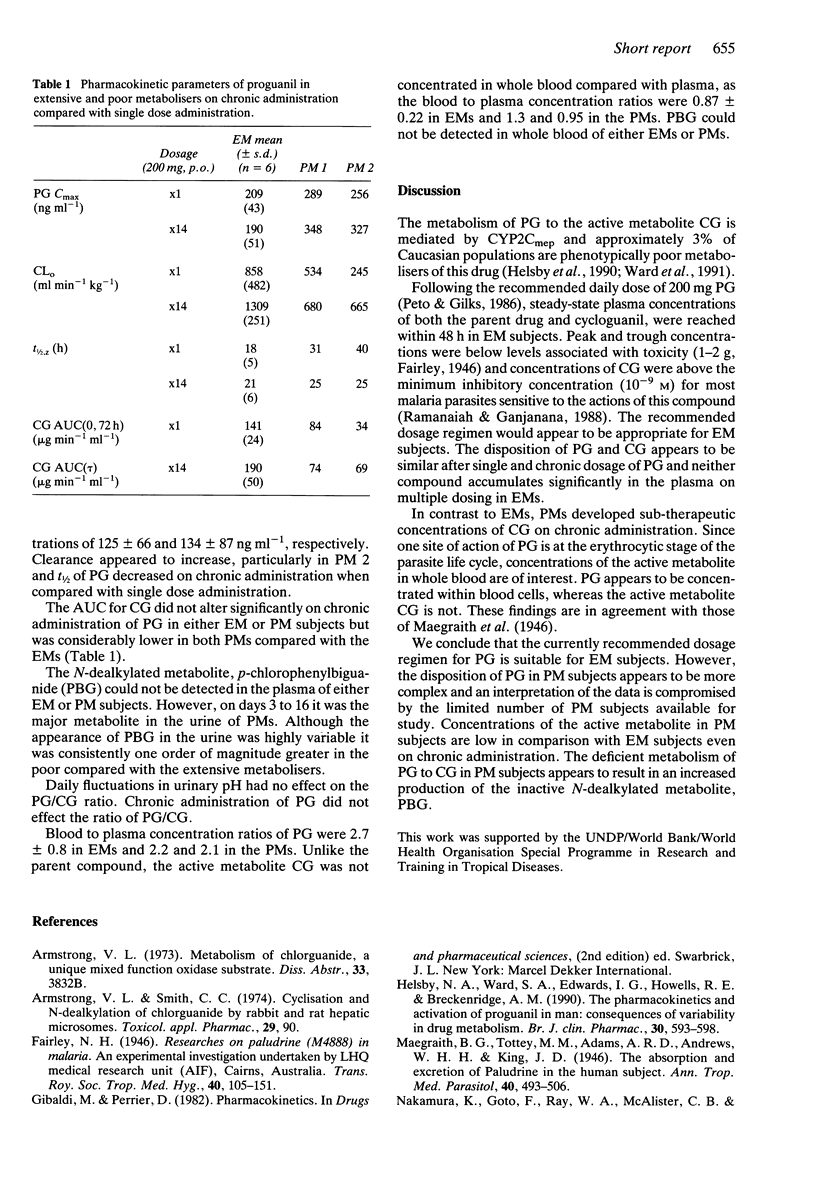Abstract
Proguanil, a prophylactic antimalarial agent, is metabolised by the polymorphic isoenzyme CYP2Cmep in man. In this study the multiple dose pharmacokinetics of proguanil were investigated in subjects who were phenotyped previously as extensive (n = 6) or poor (n = 2) metabolisers of the drug. Steady-state plasma concentrations of proguanil were achieved within 48 h in extensive metaboliser subjects and chronic administration of the drug did not appear to alter the disposition of proguanil or that of its active metabolite, cycloguanil. The currently recommended dosage regimen appears to be appropriate for extensive metabolisers of proguanil. Poor metabolisers of proguanil had significantly lower plasma concentrations of the active metabolite cycloguanil compared with extensive metabolisers. Thus, even on multiple dose administration these subjects may not achieve adequate plasma concentrations of cycloguanil. Deficient metabolism of proguanil to cycloguanil leads to an increased appearance of the N-dealkylated metabolite p-chlorphenylbiguanide in the urine of poor metabolisers.
Full text
PDF



Selected References
These references are in PubMed. This may not be the complete list of references from this article.
- Helsby N. A., Ward S. A., Edwards G., Howells R. E., Breckenridge A. M. The pharmacokinetics and activation of proguanil in man: consequences of variability in drug metabolism. Br J Clin Pharmacol. 1990 Oct;30(4):593–598. doi: 10.1111/j.1365-2125.1990.tb03818.x. [DOI] [PMC free article] [PubMed] [Google Scholar]
- Nakamura K., Goto F., Ray W. A., McAllister C. B., Jacqz E., Wilkinson G. R., Branch R. A. Interethnic differences in genetic polymorphism of debrisoquin and mephenytoin hydroxylation between Japanese and Caucasian populations. Clin Pharmacol Ther. 1985 Oct;38(4):402–408. doi: 10.1038/clpt.1985.194. [DOI] [PubMed] [Google Scholar]
- Peto T. E., Gilks C. F. Strategies for the prevention of malaria in travellers: comparison of drug regimens by means of risk-benefit analysis. Lancet. 1986 May 31;1(8492):1256–1261. doi: 10.1016/s0140-6736(86)91395-4. [DOI] [PubMed] [Google Scholar]
- Ramanaiah T. V., Gajanana A. Superior antimalarial activity of proguanil to cycloguanil after in vitro bioconversion. Trans R Soc Trop Med Hyg. 1988;82(3):358–359. doi: 10.1016/0035-9203(88)90115-0. [DOI] [PubMed] [Google Scholar]
- Ward S. A., Helsby N. A., Skjelbo E., Brøsen K., Gram L. F., Breckenridge A. M. The activation of the biguanide antimalarial proguanil co-segregates with the mephenytoin oxidation polymorphism--a panel study. Br J Clin Pharmacol. 1991 Jun;31(6):689–692. doi: 10.1111/j.1365-2125.1991.tb05594.x. [DOI] [PMC free article] [PubMed] [Google Scholar]
- Watkins W. M., Mberu E. K., Nevill C. G., Ward S. A., Breckenridge A. M., Koech D. K. Variability in the metabolism of proguanil to the active metabolite cycloguanil in healthy Kenyan adults. Trans R Soc Trop Med Hyg. 1990 Jul-Aug;84(4):492–495. doi: 10.1016/0035-9203(90)90010-c. [DOI] [PubMed] [Google Scholar]


